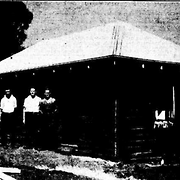
Self help, 30 May 1935, courtesy of National Library of Australia.
Details
Chandler Boys' Farm was established in 1932 on a property at Seven Hills, in Roelands, near Bunbury as a privately-run training centre for unemployed boys aged over 14 years. Some of these youths were settled on farms of their own. The Chandler Boys' Farm closed in 1937 and the land was used from 1938 for the Roelands Native Mission Farm.
Chandler Boys' Farm Chandler Boys' Farm was established in December 1932 on a property owned by Mr Albany Bell at Seven Hills on the banks of the Collie River at Roelands, near Bunbury. It was a training centre for up to 20 unemployed boys who were selected for placement. Some had parents who paid fees, but others were subsidised.
The farm was named after Mr TC Chandler, headmaster of the Perth Boys' School, who initiated the scheme in 1931 as boys leaving school during the Depression were finding it difficult to get work. It was run by the Chandler Boys' Settlement Scheme (Inc.) which had been established for the purpose. The president of the committee was the parliamentarian Mr LB Bolton, MLC and the scheme had a lot of political support. The ability of the farm to run at very little cost was proudly reported in the press and it relied on donations and the sale of produce.
Chandler Boys' Farm began with seven boys living in tents and having training in farm skills. By the end of its first year, 18 boys were in residence and visitors at the official opening ceremony in October 1933 were fed on produce from the farm.
By October 1934, four trainees had been given individual plots of ground to farm. They would continue to live at Chandler and 'be amendable to camp discipline', working full time on their blocks 'under the general supervision of the manager' according to a newspaper report at the time.
In the second half of 1936, other trainees were placed on their own farms at Jardee with finance arranged through the Agricultural bank and deposits raised through the savings the youths had made from their employment at Chandler. Others had received help from family to acquire farms.
In February 1937, after the death of Mr Chandler and illness of the President, Mr Bolton, the committee was unable to raise more money to support the venture. They appealed to the Lotteries Commission, which gave some support, but the farm could not overcome losses sustained in the last year of its operations. In its refusal to give additional support, the Lotteries Commission said that there was no longer the need for such a scheme by 1937, there had been few applicants to the farm school, the capital costs were not justified by the small number of trainees and there was a greater need in the community for boys to be trained directly on farms, as farmers needed the labour.
Around 120 boys had been trainees at the Chandler Boys' Farm during 1932 and 1937, when it closed.
By July 1938, Mr Albany Bell had received government approval to establish the Roelands Native Mission Farm on the property.
Sources used to compile this entry: 'On the Chandler Boys' Farm', The West Australian, 7 December 1932, p. 16, http://nla.gov.au/nla.news-article32572157; 'Chandler Boys' Farm [Opening]', Western Mail, Charles Harper, J.W. Hackett, James Gibey, for the Western mail office, Perth, 12 October 1933, p. 42, http://nla.gov.au/nla.news-article37837434; 'Chandler Boys' Farm', The West Australian, 26 December 1934, p. 9, http://nla.gov.au/nla.news-article32803141; 'The Chandler Boys' Farm', Sunday Times, 10 June 1934, p. 22, http://nla.gov.au/nla.news-article61197248; 'Chandler Boys' Farm Progress', The Daily News, 22 October 1934, p. 2, http://nla.gov.au/nla.news-article85739918; 'Chandler Boys' Farm Scheme', The West Australian, 7 June 1934, p. 22, http://nla.gov.au/nla.news-article33242816; 'Chandler Boys' Farm [1936]', The West Australian, 23 June 1926, p. 17, http://nla.gov.au/nla.news-article40727385; 'Chandler Farm. Decision to close down', The West Australian, 16 February 1937, p. 17, http://nla.gov.au/nla.news-article41277617; 'In Brief. The Chandler Farm', Western Mail, Charles Harper, J.W. Hackett, James Gibey, for the Western mail office, Perth, 18 February 1937, p. 7, http://nla.gov.au/nla.news-article38901775; 'Chandler Boys' Farm [1938]', The West Australian, 21 July 1938, p. 7, http://nla.gov.au/nla.news-article42098014; Information Services, Department for Community Development, Signposts: A Guide for Children and Young People in Care in WA from 1920, Government of Western Australia, 2004, https://signposts.communities.wa.gov.au//pdf/pdf.aspx.
Prepared by: Debra Rosser
Created: 15 March 2011, Last modified: 18 June 2014